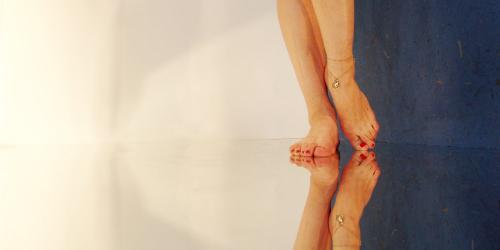"The foot is a complex member, with 27 bones and a lot of joints, and on a daily basis it is extremely sought after," explains Nicolas Grenot, editor of the Revue du Podologue. This constant solicitation explains that one in five French people feels pain in the feet. What about dry feet? If women are affected as much as men, they are also sensitive - in particular: open shoes!
The foot, a naturally dry area prone to calluses
Dry skin on the feet is common. Indeed, the foot is naturally poor in sebaceous glands, which nourishes the skin and avoids dry feet. Moreover, with age, the feet produce less and less sebum and are becoming more dry.
"Contrary to what one imagines, sweating does not avoid the drought," says Nicolas Grenot. The most sensitive part is of course the heel, on which one can observe heel calluses, of the horn which, if not treated, can cause cracks and then crevasses. The latter are extremely painful.
"Hyperkeratosis - dryness of the skin - is due to excessive heel pressure: the skin seeks to protect itself and creates horn, and if there is too much there is a risk of cracking. the cracks remain on the surface, or on the epidermis, it is superficial. As soon as one reaches the dermis, it becomes very painful, "explains Nicolas Grenot.
Factors that accentuate dry feet
While some people are naturally more prone to dry skin than others, there are also factors that favor dry feet.
The wearing of shoes without buttress or without flange at the back - the everyday flip-flops are to be banished, favor the dry feet! The same goes for the synthetic materials (stockings, tights) that cause more perspiration, which results in drying the skin.
Age or potential illnesses such as diabetes or venous insufficiency, which increase sensitivity to dry skin, should also be considered.
Nicolas Grenot warns: "Be careful, some people who have dry feet use an electric grater every day, and the more you scrub, the more the horn comes back." The right rhythm? Once a week and without excess, using an electric grater or hand grater in emery cloth, on dry feet and not wet!
Of course, when hyperkeratosis is too great, it is better to consult a podiatrist for further treatment.
What products to prevent and repair dry feet and heels?
To avoid hyperkeratosis and painful callosities, there are many creams, scrubs and other specific masks to apply daily - as would be done for the skin of his face or hands. "When there is hyperkeratosis, a shock treatment is often proposed, with a very strong cream to be applied to the feet." The rest of the time, we will wash with cream enriched with moisturizing and nourishing agents (urea, shea, cold cream ...) to soften the skin. The trick in addition: put cotton socks on cream feet before going to bed!
Finally, to cure crevasses, no cosmetic miracle in view: podiatrists usually prescribe a kind of varnish that will allow the healing of the foot.
Two home recipes to take care of dry feet
"Sweating promotes drought, so it is necessary to treat it, even if it is not simple," explains Nicolas Grenot. His miracle recipe? "Take a foot bath with two or three teabags infused in lukewarm water and let your feet soak for 15 minutes and then dry thoroughly." This foot bath helps tighten pores and therefore limits sweating.
To exfoliate dry feet, Nicolas Grenot advocates a recipe based on olive oil and coarse salt: it is rubbed gently and here are feet very soft. For hydration, a crushed mature avocado would do wonders. As for people who suffer from venous insufficiency - which causes a dryness of the skin - he recommends the Scottish shower: one alternates lukewarm water and cooler and one ends with a jet of cold water.



